Report on Communication in the Business Environment: ALDI Case Study
VerifiedAdded on 2020/06/04
|11
|3475
|89
Report
AI Summary
This report provides a comprehensive analysis of business communication, focusing on its vital role in organizational success. The report begins by highlighting the importance of communication for both internal and external stakeholders, using ALDI as a case study to illustrate practical applications. It explores different communication models, including linear, interactive, and transactional models, and evaluates the effectiveness of various communication systems such as letters, memos, meetings, email, and social media. The report also examines factors influencing the choice of communication media, the significance of grammar, punctuation, and sentence structure, and strategies for planning and structuring communication. Furthermore, it addresses communication barriers, the use of communication theories and body language, and proofreading techniques. The report then delves into identifying the audience and purpose, selecting appropriate communication media, and the significance of format, layout, and style. It also covers written communication, style and content, and meeting deadlines. Finally, the report discusses the nature, purpose, and use of information, the importance of correct language, body language, and tone of voice, and the confirmation of message understanding, concluding with appropriate organizational responses. This report is designed to provide valuable insights into effective business communication strategies and their practical implementation.
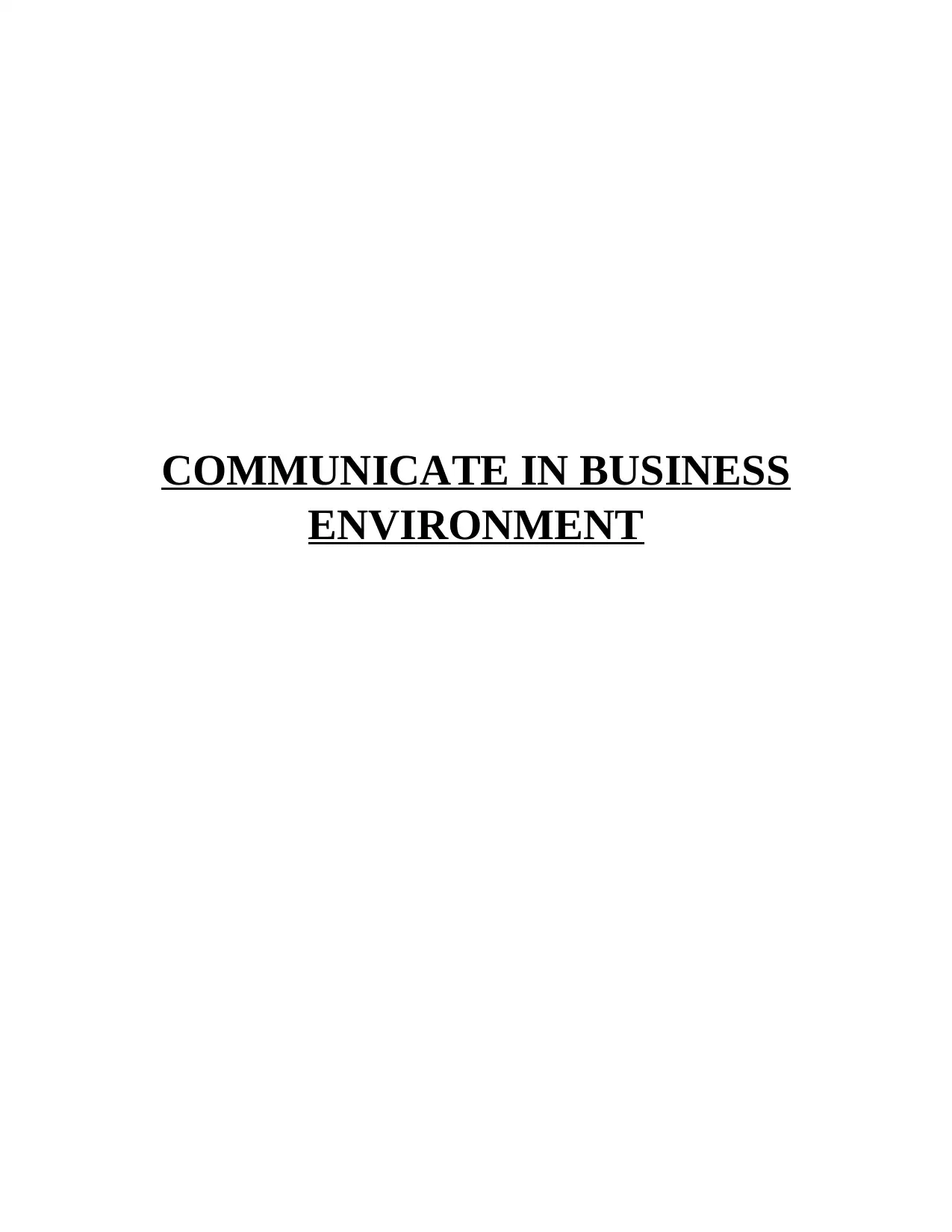
COMMUNICATE IN BUSINESS
ENVIRONMENT
ENVIRONMENT
Paraphrase This Document
Need a fresh take? Get an instant paraphrase of this document with our AI Paraphraser

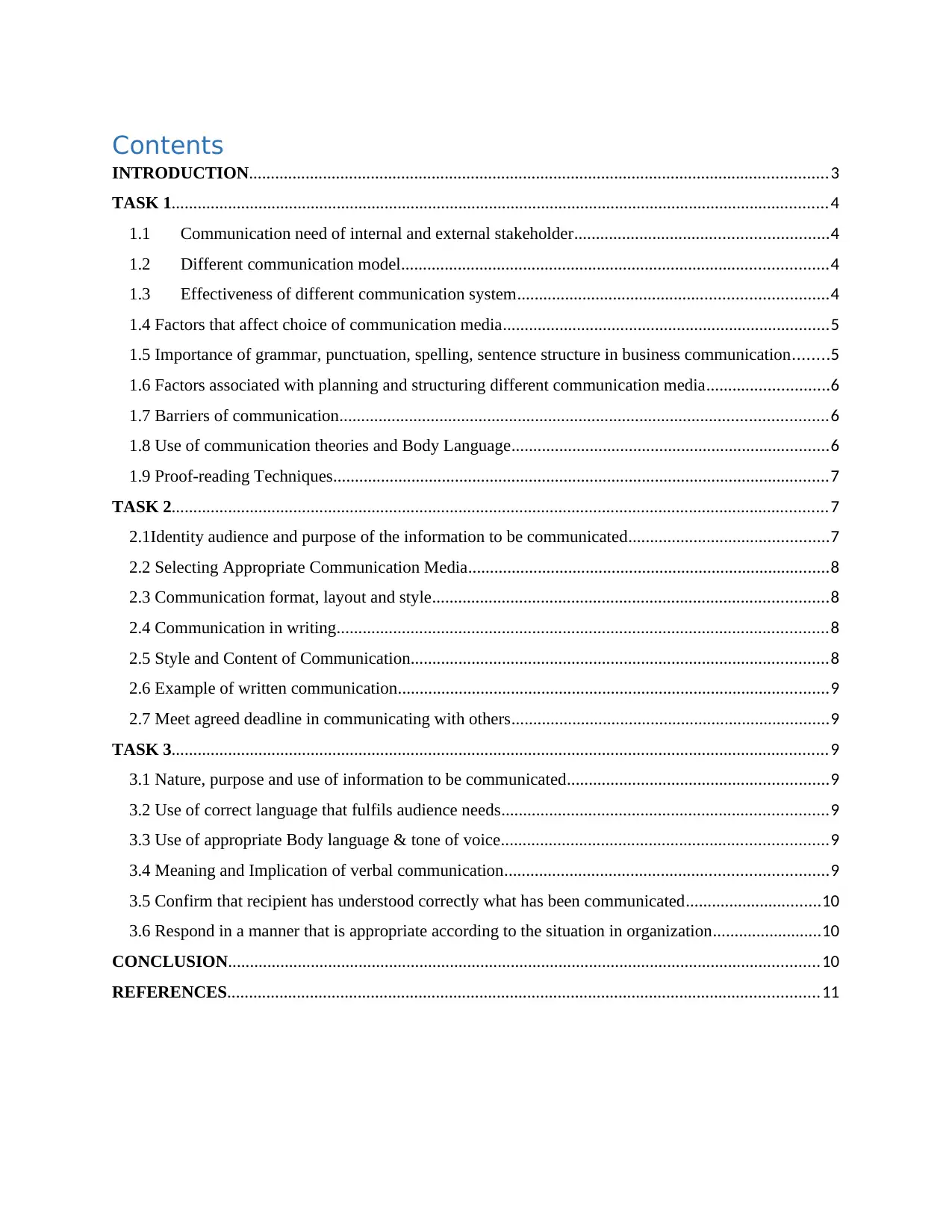
Contents
INTRODUCTION.....................................................................................................................................3
TASK 1.......................................................................................................................................................4
1.1 Communication need of internal and external stakeholder..........................................................4
1.2 Different communication model..................................................................................................4
1.3 Effectiveness of different communication system.......................................................................4
1.4 Factors that affect choice of communication media...........................................................................5
1.5 Importance of grammar, punctuation, spelling, sentence structure in business communication........5
1.6 Factors associated with planning and structuring different communication media............................6
1.7 Barriers of communication................................................................................................................6
1.8 Use of communication theories and Body Language.........................................................................6
1.9 Proof-reading Techniques..................................................................................................................7
TASK 2.......................................................................................................................................................7
2.1Identity audience and purpose of the information to be communicated..............................................7
2.2 Selecting Appropriate Communication Media...................................................................................8
2.3 Communication format, layout and style...........................................................................................8
2.4 Communication in writing.................................................................................................................8
2.5 Style and Content of Communication................................................................................................8
2.6 Example of written communication...................................................................................................9
2.7 Meet agreed deadline in communicating with others.........................................................................9
TASK 3.......................................................................................................................................................9
3.1 Nature, purpose and use of information to be communicated............................................................9
3.2 Use of correct language that fulfils audience needs...........................................................................9
3.3 Use of appropriate Body language & tone of voice...........................................................................9
3.4 Meaning and Implication of verbal communication..........................................................................9
3.5 Confirm that recipient has understood correctly what has been communicated...............................10
3.6 Respond in a manner that is appropriate according to the situation in organization.........................10
CONCLUSION........................................................................................................................................10
REFERENCES........................................................................................................................................11
INTRODUCTION.....................................................................................................................................3
TASK 1.......................................................................................................................................................4
1.1 Communication need of internal and external stakeholder..........................................................4
1.2 Different communication model..................................................................................................4
1.3 Effectiveness of different communication system.......................................................................4
1.4 Factors that affect choice of communication media...........................................................................5
1.5 Importance of grammar, punctuation, spelling, sentence structure in business communication........5
1.6 Factors associated with planning and structuring different communication media............................6
1.7 Barriers of communication................................................................................................................6
1.8 Use of communication theories and Body Language.........................................................................6
1.9 Proof-reading Techniques..................................................................................................................7
TASK 2.......................................................................................................................................................7
2.1Identity audience and purpose of the information to be communicated..............................................7
2.2 Selecting Appropriate Communication Media...................................................................................8
2.3 Communication format, layout and style...........................................................................................8
2.4 Communication in writing.................................................................................................................8
2.5 Style and Content of Communication................................................................................................8
2.6 Example of written communication...................................................................................................9
2.7 Meet agreed deadline in communicating with others.........................................................................9
TASK 3.......................................................................................................................................................9
3.1 Nature, purpose and use of information to be communicated............................................................9
3.2 Use of correct language that fulfils audience needs...........................................................................9
3.3 Use of appropriate Body language & tone of voice...........................................................................9
3.4 Meaning and Implication of verbal communication..........................................................................9
3.5 Confirm that recipient has understood correctly what has been communicated...............................10
3.6 Respond in a manner that is appropriate according to the situation in organization.........................10
CONCLUSION........................................................................................................................................10
REFERENCES........................................................................................................................................11
You're viewing a preview
Unlock full access by subscribing today!
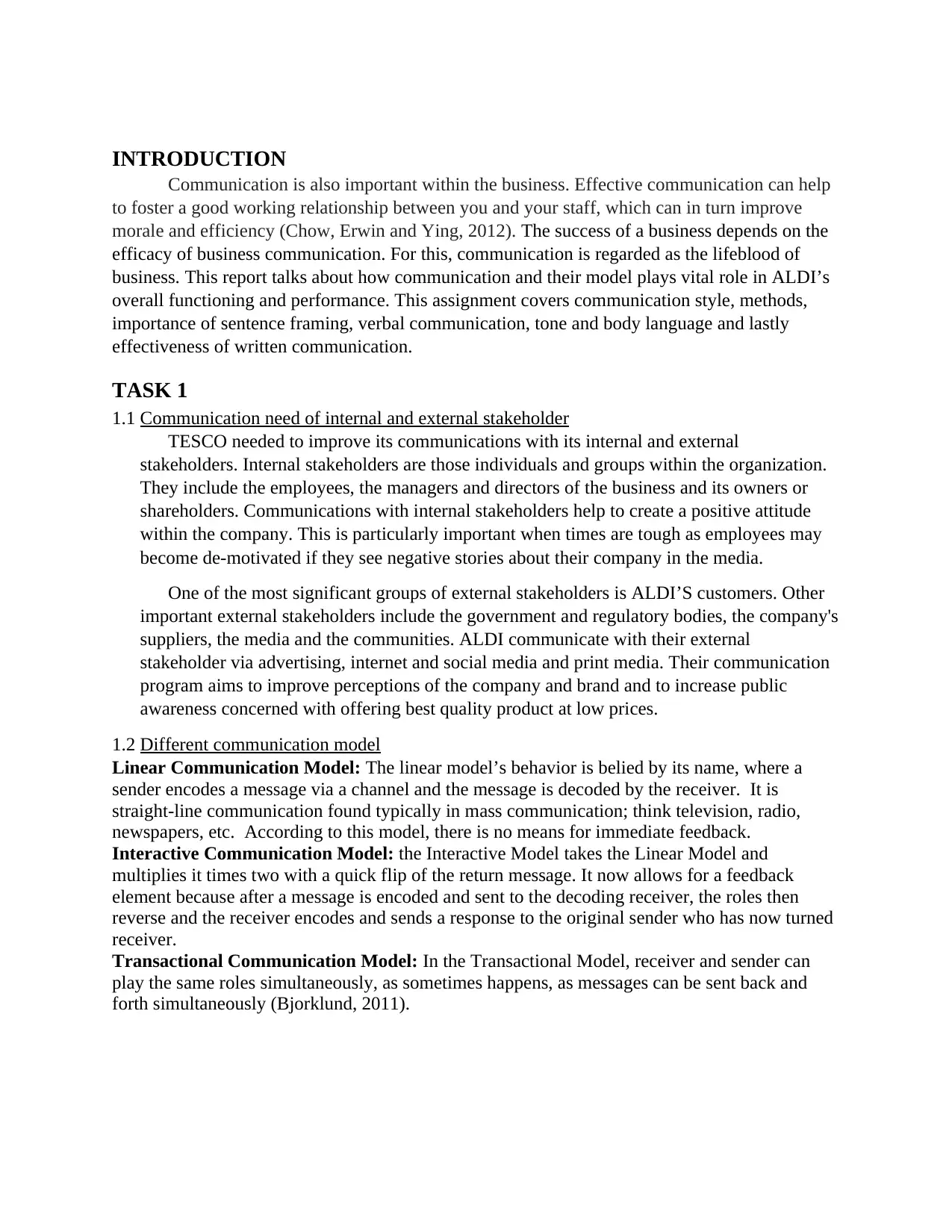
INTRODUCTION
Communication is also important within the business. Effective communication can help
to foster a good working relationship between you and your staff, which can in turn improve
morale and efficiency (Chow, Erwin and Ying, 2012). The success of a business depends on the
efficacy of business communication. For this, communication is regarded as the lifeblood of
business. This report talks about how communication and their model plays vital role in ALDI’s
overall functioning and performance. This assignment covers communication style, methods,
importance of sentence framing, verbal communication, tone and body language and lastly
effectiveness of written communication.
TASK 1
1.1 Communication need of internal and external stakeholder
TESCO needed to improve its communications with its internal and external
stakeholders. Internal stakeholders are those individuals and groups within the organization.
They include the employees, the managers and directors of the business and its owners or
shareholders. Communications with internal stakeholders help to create a positive attitude
within the company. This is particularly important when times are tough as employees may
become de-motivated if they see negative stories about their company in the media.
One of the most significant groups of external stakeholders is ALDI’S customers. Other
important external stakeholders include the government and regulatory bodies, the company's
suppliers, the media and the communities. ALDI communicate with their external
stakeholder via advertising, internet and social media and print media. Their communication
program aims to improve perceptions of the company and brand and to increase public
awareness concerned with offering best quality product at low prices.
1.2 Different communication model
Linear Communication Model: The linear model’s behavior is belied by its name, where a
sender encodes a message via a channel and the message is decoded by the receiver. It is
straight-line communication found typically in mass communication; think television, radio,
newspapers, etc. According to this model, there is no means for immediate feedback.
Interactive Communication Model: the Interactive Model takes the Linear Model and
multiplies it times two with a quick flip of the return message. It now allows for a feedback
element because after a message is encoded and sent to the decoding receiver, the roles then
reverse and the receiver encodes and sends a response to the original sender who has now turned
receiver.
Transactional Communication Model: In the Transactional Model, receiver and sender can
play the same roles simultaneously, as sometimes happens, as messages can be sent back and
forth simultaneously (Bjorklund, 2011).
Communication is also important within the business. Effective communication can help
to foster a good working relationship between you and your staff, which can in turn improve
morale and efficiency (Chow, Erwin and Ying, 2012). The success of a business depends on the
efficacy of business communication. For this, communication is regarded as the lifeblood of
business. This report talks about how communication and their model plays vital role in ALDI’s
overall functioning and performance. This assignment covers communication style, methods,
importance of sentence framing, verbal communication, tone and body language and lastly
effectiveness of written communication.
TASK 1
1.1 Communication need of internal and external stakeholder
TESCO needed to improve its communications with its internal and external
stakeholders. Internal stakeholders are those individuals and groups within the organization.
They include the employees, the managers and directors of the business and its owners or
shareholders. Communications with internal stakeholders help to create a positive attitude
within the company. This is particularly important when times are tough as employees may
become de-motivated if they see negative stories about their company in the media.
One of the most significant groups of external stakeholders is ALDI’S customers. Other
important external stakeholders include the government and regulatory bodies, the company's
suppliers, the media and the communities. ALDI communicate with their external
stakeholder via advertising, internet and social media and print media. Their communication
program aims to improve perceptions of the company and brand and to increase public
awareness concerned with offering best quality product at low prices.
1.2 Different communication model
Linear Communication Model: The linear model’s behavior is belied by its name, where a
sender encodes a message via a channel and the message is decoded by the receiver. It is
straight-line communication found typically in mass communication; think television, radio,
newspapers, etc. According to this model, there is no means for immediate feedback.
Interactive Communication Model: the Interactive Model takes the Linear Model and
multiplies it times two with a quick flip of the return message. It now allows for a feedback
element because after a message is encoded and sent to the decoding receiver, the roles then
reverse and the receiver encodes and sends a response to the original sender who has now turned
receiver.
Transactional Communication Model: In the Transactional Model, receiver and sender can
play the same roles simultaneously, as sometimes happens, as messages can be sent back and
forth simultaneously (Bjorklund, 2011).
Paraphrase This Document
Need a fresh take? Get an instant paraphrase of this document with our AI Paraphraser
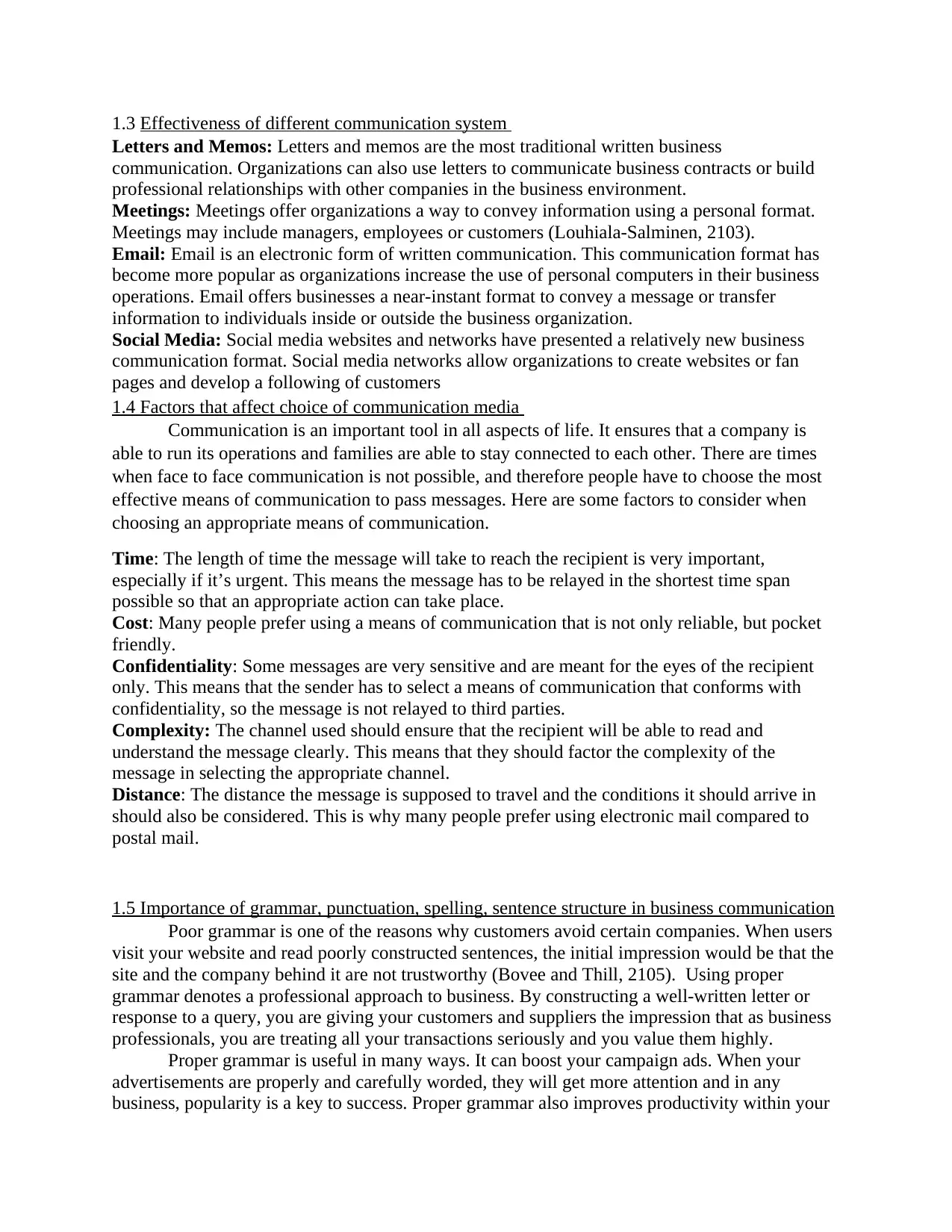
1.3 Effectiveness of different communication system
Letters and Memos: Letters and memos are the most traditional written business
communication. Organizations can also use letters to communicate business contracts or build
professional relationships with other companies in the business environment.
Meetings: Meetings offer organizations a way to convey information using a personal format.
Meetings may include managers, employees or customers (Louhiala-Salminen, 2103).
Email: Email is an electronic form of written communication. This communication format has
become more popular as organizations increase the use of personal computers in their business
operations. Email offers businesses a near-instant format to convey a message or transfer
information to individuals inside or outside the business organization.
Social Media: Social media websites and networks have presented a relatively new business
communication format. Social media networks allow organizations to create websites or fan
pages and develop a following of customers
1.4 Factors that affect choice of communication media
Communication is an important tool in all aspects of life. It ensures that a company is
able to run its operations and families are able to stay connected to each other. There are times
when face to face communication is not possible, and therefore people have to choose the most
effective means of communication to pass messages. Here are some factors to consider when
choosing an appropriate means of communication.
Time: The length of time the message will take to reach the recipient is very important,
especially if it’s urgent. This means the message has to be relayed in the shortest time span
possible so that an appropriate action can take place.
Cost: Many people prefer using a means of communication that is not only reliable, but pocket
friendly.
Confidentiality: Some messages are very sensitive and are meant for the eyes of the recipient
only. This means that the sender has to select a means of communication that conforms with
confidentiality, so the message is not relayed to third parties.
Complexity: The channel used should ensure that the recipient will be able to read and
understand the message clearly. This means that they should factor the complexity of the
message in selecting the appropriate channel.
Distance: The distance the message is supposed to travel and the conditions it should arrive in
should also be considered. This is why many people prefer using electronic mail compared to
postal mail.
1.5 Importance of grammar, punctuation, spelling, sentence structure in business communication
Poor grammar is one of the reasons why customers avoid certain companies. When users
visit your website and read poorly constructed sentences, the initial impression would be that the
site and the company behind it are not trustworthy (Bovee and Thill, 2105). Using proper
grammar denotes a professional approach to business. By constructing a well-written letter or
response to a query, you are giving your customers and suppliers the impression that as business
professionals, you are treating all your transactions seriously and you value them highly.
Proper grammar is useful in many ways. It can boost your campaign ads. When your
advertisements are properly and carefully worded, they will get more attention and in any
business, popularity is a key to success. Proper grammar also improves productivity within your
Letters and Memos: Letters and memos are the most traditional written business
communication. Organizations can also use letters to communicate business contracts or build
professional relationships with other companies in the business environment.
Meetings: Meetings offer organizations a way to convey information using a personal format.
Meetings may include managers, employees or customers (Louhiala-Salminen, 2103).
Email: Email is an electronic form of written communication. This communication format has
become more popular as organizations increase the use of personal computers in their business
operations. Email offers businesses a near-instant format to convey a message or transfer
information to individuals inside or outside the business organization.
Social Media: Social media websites and networks have presented a relatively new business
communication format. Social media networks allow organizations to create websites or fan
pages and develop a following of customers
1.4 Factors that affect choice of communication media
Communication is an important tool in all aspects of life. It ensures that a company is
able to run its operations and families are able to stay connected to each other. There are times
when face to face communication is not possible, and therefore people have to choose the most
effective means of communication to pass messages. Here are some factors to consider when
choosing an appropriate means of communication.
Time: The length of time the message will take to reach the recipient is very important,
especially if it’s urgent. This means the message has to be relayed in the shortest time span
possible so that an appropriate action can take place.
Cost: Many people prefer using a means of communication that is not only reliable, but pocket
friendly.
Confidentiality: Some messages are very sensitive and are meant for the eyes of the recipient
only. This means that the sender has to select a means of communication that conforms with
confidentiality, so the message is not relayed to third parties.
Complexity: The channel used should ensure that the recipient will be able to read and
understand the message clearly. This means that they should factor the complexity of the
message in selecting the appropriate channel.
Distance: The distance the message is supposed to travel and the conditions it should arrive in
should also be considered. This is why many people prefer using electronic mail compared to
postal mail.
1.5 Importance of grammar, punctuation, spelling, sentence structure in business communication
Poor grammar is one of the reasons why customers avoid certain companies. When users
visit your website and read poorly constructed sentences, the initial impression would be that the
site and the company behind it are not trustworthy (Bovee and Thill, 2105). Using proper
grammar denotes a professional approach to business. By constructing a well-written letter or
response to a query, you are giving your customers and suppliers the impression that as business
professionals, you are treating all your transactions seriously and you value them highly.
Proper grammar is useful in many ways. It can boost your campaign ads. When your
advertisements are properly and carefully worded, they will get more attention and in any
business, popularity is a key to success. Proper grammar also improves productivity within your
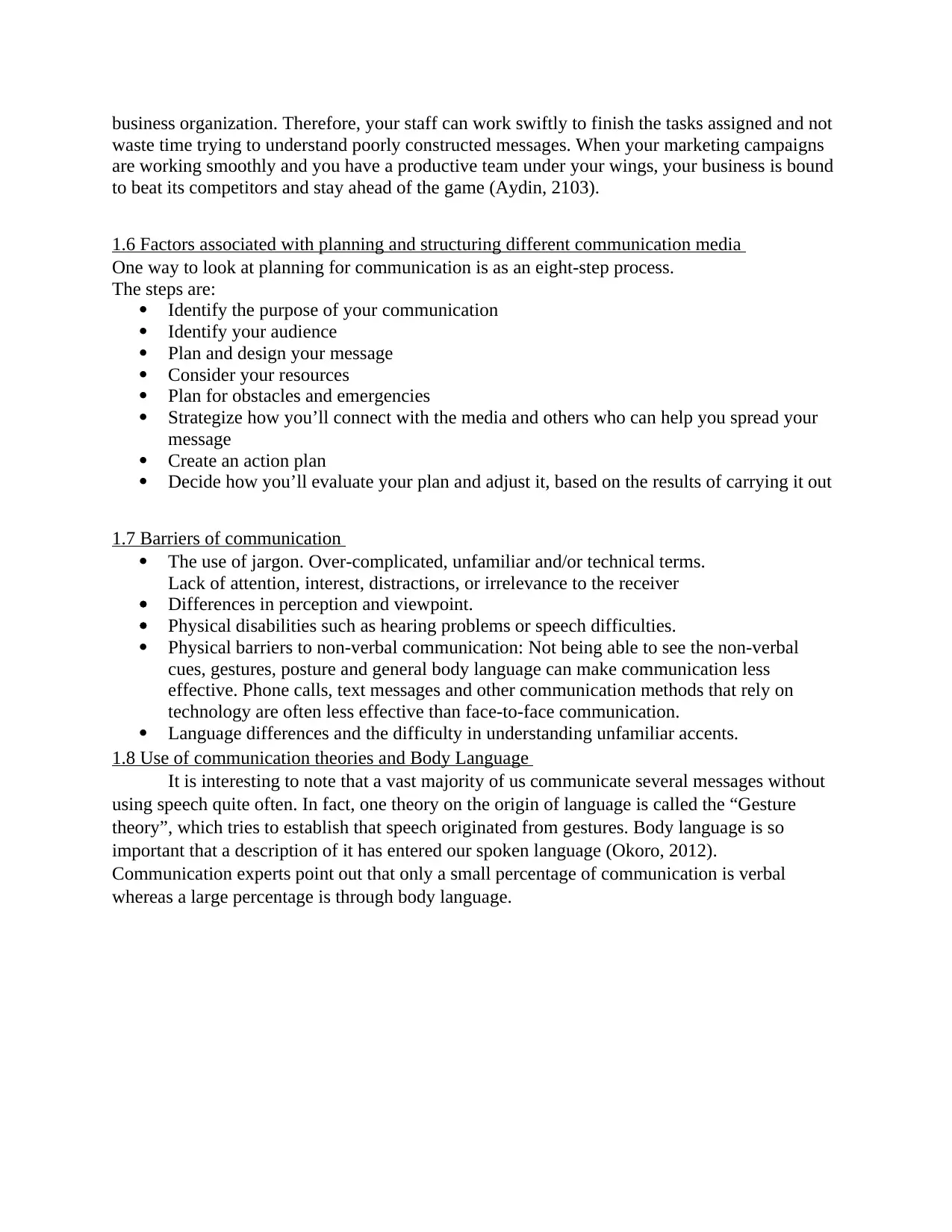
business organization. Therefore, your staff can work swiftly to finish the tasks assigned and not
waste time trying to understand poorly constructed messages. When your marketing campaigns
are working smoothly and you have a productive team under your wings, your business is bound
to beat its competitors and stay ahead of the game (Aydin, 2103).
1.6 Factors associated with planning and structuring different communication media
One way to look at planning for communication is as an eight-step process.
The steps are:
Identify the purpose of your communication
Identify your audience
Plan and design your message
Consider your resources
Plan for obstacles and emergencies
Strategize how you’ll connect with the media and others who can help you spread your
message
Create an action plan
Decide how you’ll evaluate your plan and adjust it, based on the results of carrying it out
1.7 Barriers of communication
The use of jargon. Over-complicated, unfamiliar and/or technical terms.
Lack of attention, interest, distractions, or irrelevance to the receiver
Differences in perception and viewpoint.
Physical disabilities such as hearing problems or speech difficulties.
Physical barriers to non-verbal communication: Not being able to see the non-verbal
cues, gestures, posture and general body language can make communication less
effective. Phone calls, text messages and other communication methods that rely on
technology are often less effective than face-to-face communication.
Language differences and the difficulty in understanding unfamiliar accents.
1.8 Use of communication theories and Body Language
It is interesting to note that a vast majority of us communicate several messages without
using speech quite often. In fact, one theory on the origin of language is called the “Gesture
theory”, which tries to establish that speech originated from gestures. Body language is so
important that a description of it has entered our spoken language (Okoro, 2012).
Communication experts point out that only a small percentage of communication is verbal
whereas a large percentage is through body language.
waste time trying to understand poorly constructed messages. When your marketing campaigns
are working smoothly and you have a productive team under your wings, your business is bound
to beat its competitors and stay ahead of the game (Aydin, 2103).
1.6 Factors associated with planning and structuring different communication media
One way to look at planning for communication is as an eight-step process.
The steps are:
Identify the purpose of your communication
Identify your audience
Plan and design your message
Consider your resources
Plan for obstacles and emergencies
Strategize how you’ll connect with the media and others who can help you spread your
message
Create an action plan
Decide how you’ll evaluate your plan and adjust it, based on the results of carrying it out
1.7 Barriers of communication
The use of jargon. Over-complicated, unfamiliar and/or technical terms.
Lack of attention, interest, distractions, or irrelevance to the receiver
Differences in perception and viewpoint.
Physical disabilities such as hearing problems or speech difficulties.
Physical barriers to non-verbal communication: Not being able to see the non-verbal
cues, gestures, posture and general body language can make communication less
effective. Phone calls, text messages and other communication methods that rely on
technology are often less effective than face-to-face communication.
Language differences and the difficulty in understanding unfamiliar accents.
1.8 Use of communication theories and Body Language
It is interesting to note that a vast majority of us communicate several messages without
using speech quite often. In fact, one theory on the origin of language is called the “Gesture
theory”, which tries to establish that speech originated from gestures. Body language is so
important that a description of it has entered our spoken language (Okoro, 2012).
Communication experts point out that only a small percentage of communication is verbal
whereas a large percentage is through body language.
You're viewing a preview
Unlock full access by subscribing today!
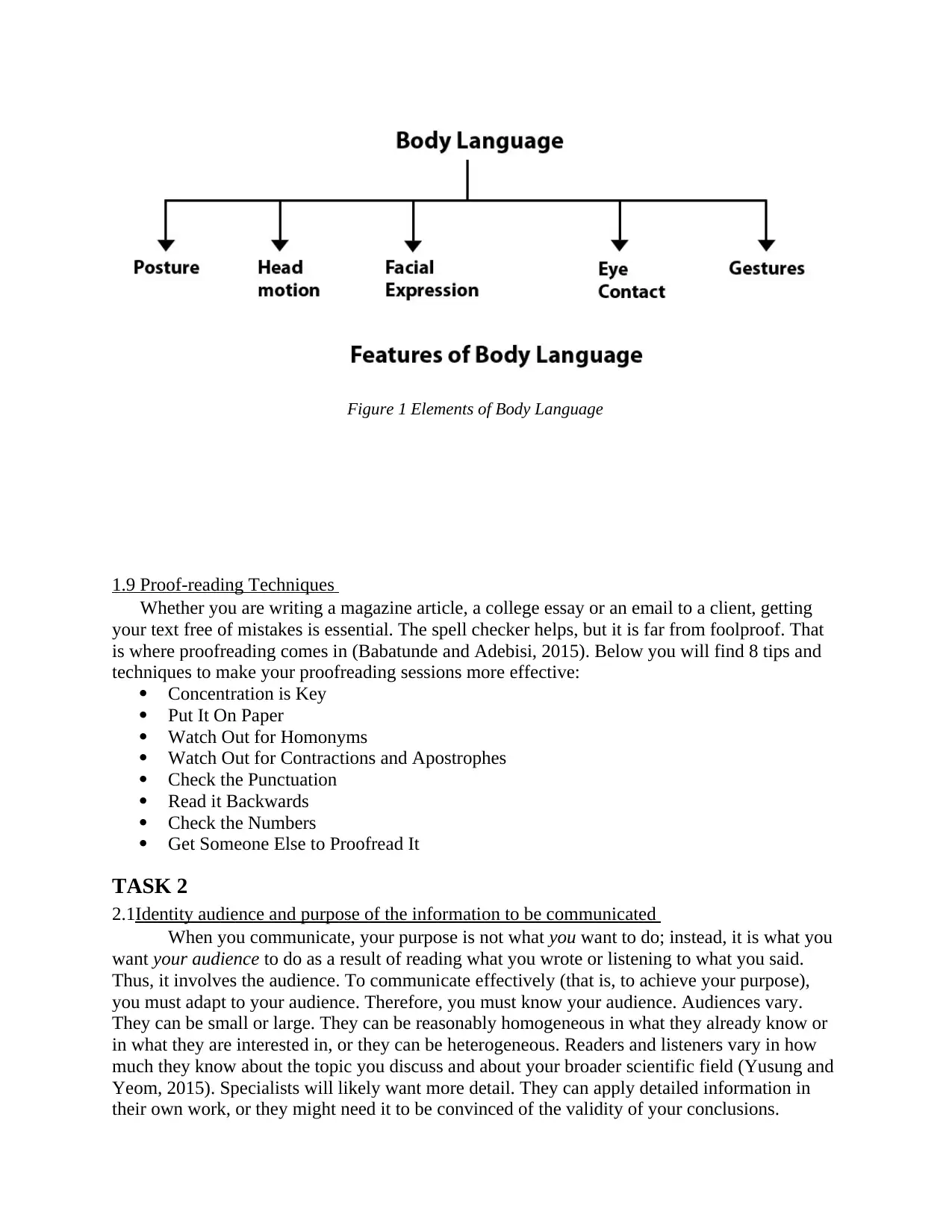
Figure 1 Elements of Body Language
1.9 Proof-reading Techniques
Whether you are writing a magazine article, a college essay or an email to a client, getting
your text free of mistakes is essential. The spell checker helps, but it is far from foolproof. That
is where proofreading comes in (Babatunde and Adebisi, 2015). Below you will find 8 tips and
techniques to make your proofreading sessions more effective:
Concentration is Key
Put It On Paper
Watch Out for Homonyms
Watch Out for Contractions and Apostrophes
Check the Punctuation
Read it Backwards
Check the Numbers
Get Someone Else to Proofread It
TASK 2
2.1Identity audience and purpose of the information to be communicated
When you communicate, your purpose is not what you want to do; instead, it is what you
want your audience to do as a result of reading what you wrote or listening to what you said.
Thus, it involves the audience. To communicate effectively (that is, to achieve your purpose),
you must adapt to your audience. Therefore, you must know your audience. Audiences vary.
They can be small or large. They can be reasonably homogeneous in what they already know or
in what they are interested in, or they can be heterogeneous. Readers and listeners vary in how
much they know about the topic you discuss and about your broader scientific field (Yusung and
Yeom, 2015). Specialists will likely want more detail. They can apply detailed information in
their own work, or they might need it to be convinced of the validity of your conclusions.
1.9 Proof-reading Techniques
Whether you are writing a magazine article, a college essay or an email to a client, getting
your text free of mistakes is essential. The spell checker helps, but it is far from foolproof. That
is where proofreading comes in (Babatunde and Adebisi, 2015). Below you will find 8 tips and
techniques to make your proofreading sessions more effective:
Concentration is Key
Put It On Paper
Watch Out for Homonyms
Watch Out for Contractions and Apostrophes
Check the Punctuation
Read it Backwards
Check the Numbers
Get Someone Else to Proofread It
TASK 2
2.1Identity audience and purpose of the information to be communicated
When you communicate, your purpose is not what you want to do; instead, it is what you
want your audience to do as a result of reading what you wrote or listening to what you said.
Thus, it involves the audience. To communicate effectively (that is, to achieve your purpose),
you must adapt to your audience. Therefore, you must know your audience. Audiences vary.
They can be small or large. They can be reasonably homogeneous in what they already know or
in what they are interested in, or they can be heterogeneous. Readers and listeners vary in how
much they know about the topic you discuss and about your broader scientific field (Yusung and
Yeom, 2015). Specialists will likely want more detail. They can apply detailed information in
their own work, or they might need it to be convinced of the validity of your conclusions.
Paraphrase This Document
Need a fresh take? Get an instant paraphrase of this document with our AI Paraphraser
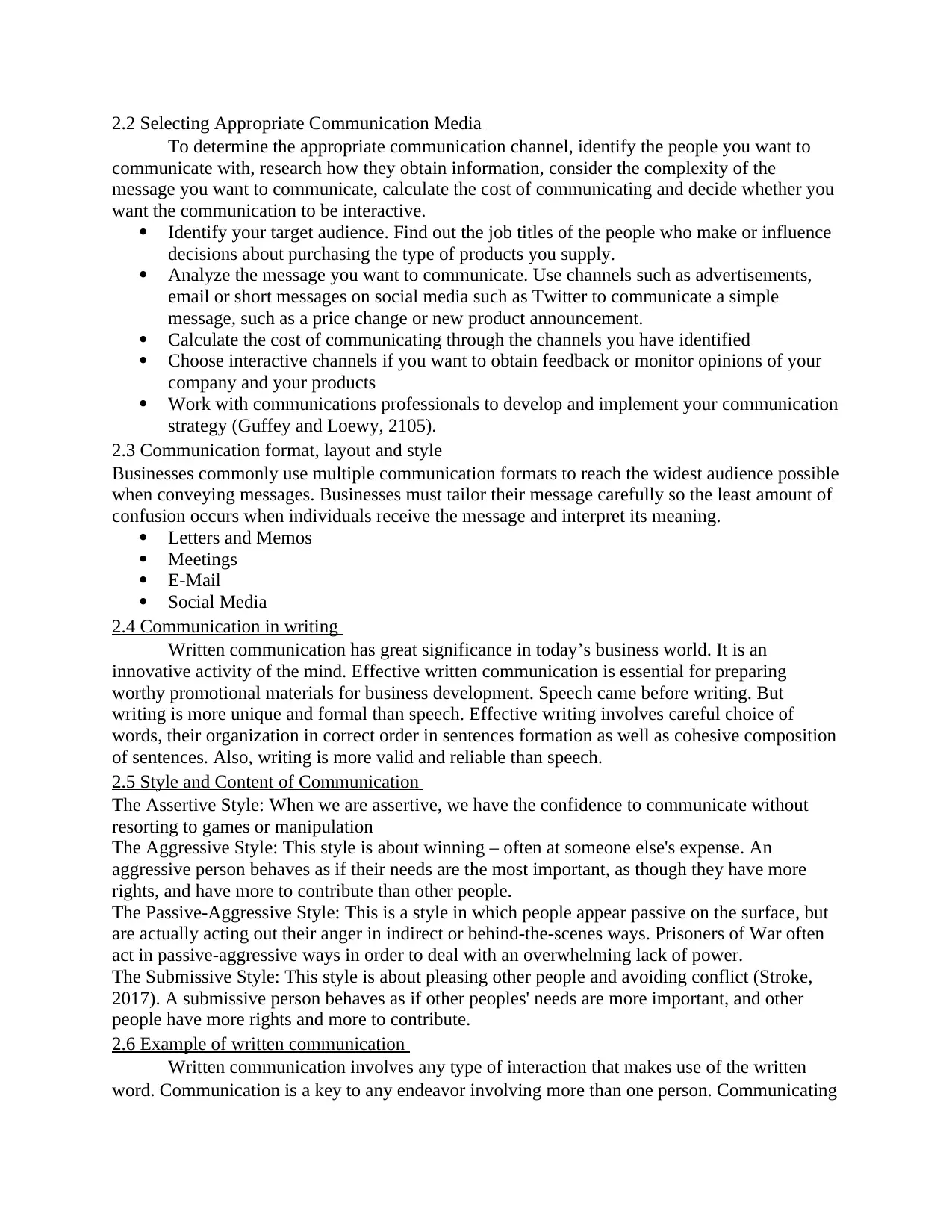
2.2 Selecting Appropriate Communication Media
To determine the appropriate communication channel, identify the people you want to
communicate with, research how they obtain information, consider the complexity of the
message you want to communicate, calculate the cost of communicating and decide whether you
want the communication to be interactive.
Identify your target audience. Find out the job titles of the people who make or influence
decisions about purchasing the type of products you supply.
Analyze the message you want to communicate. Use channels such as advertisements,
email or short messages on social media such as Twitter to communicate a simple
message, such as a price change or new product announcement.
Calculate the cost of communicating through the channels you have identified
Choose interactive channels if you want to obtain feedback or monitor opinions of your
company and your products
Work with communications professionals to develop and implement your communication
strategy (Guffey and Loewy, 2105).
2.3 Communication format, layout and style
Businesses commonly use multiple communication formats to reach the widest audience possible
when conveying messages. Businesses must tailor their message carefully so the least amount of
confusion occurs when individuals receive the message and interpret its meaning.
Letters and Memos
Meetings
E-Mail
Social Media
2.4 Communication in writing
Written communication has great significance in today’s business world. It is an
innovative activity of the mind. Effective written communication is essential for preparing
worthy promotional materials for business development. Speech came before writing. But
writing is more unique and formal than speech. Effective writing involves careful choice of
words, their organization in correct order in sentences formation as well as cohesive composition
of sentences. Also, writing is more valid and reliable than speech.
2.5 Style and Content of Communication
The Assertive Style: When we are assertive, we have the confidence to communicate without
resorting to games or manipulation
The Aggressive Style: This style is about winning – often at someone else's expense. An
aggressive person behaves as if their needs are the most important, as though they have more
rights, and have more to contribute than other people.
The Passive-Aggressive Style: This is a style in which people appear passive on the surface, but
are actually acting out their anger in indirect or behind-the-scenes ways. Prisoners of War often
act in passive-aggressive ways in order to deal with an overwhelming lack of power.
The Submissive Style: This style is about pleasing other people and avoiding conflict (Stroke,
2017). A submissive person behaves as if other peoples' needs are more important, and other
people have more rights and more to contribute.
2.6 Example of written communication
Written communication involves any type of interaction that makes use of the written
word. Communication is a key to any endeavor involving more than one person. Communicating
To determine the appropriate communication channel, identify the people you want to
communicate with, research how they obtain information, consider the complexity of the
message you want to communicate, calculate the cost of communicating and decide whether you
want the communication to be interactive.
Identify your target audience. Find out the job titles of the people who make or influence
decisions about purchasing the type of products you supply.
Analyze the message you want to communicate. Use channels such as advertisements,
email or short messages on social media such as Twitter to communicate a simple
message, such as a price change or new product announcement.
Calculate the cost of communicating through the channels you have identified
Choose interactive channels if you want to obtain feedback or monitor opinions of your
company and your products
Work with communications professionals to develop and implement your communication
strategy (Guffey and Loewy, 2105).
2.3 Communication format, layout and style
Businesses commonly use multiple communication formats to reach the widest audience possible
when conveying messages. Businesses must tailor their message carefully so the least amount of
confusion occurs when individuals receive the message and interpret its meaning.
Letters and Memos
Meetings
Social Media
2.4 Communication in writing
Written communication has great significance in today’s business world. It is an
innovative activity of the mind. Effective written communication is essential for preparing
worthy promotional materials for business development. Speech came before writing. But
writing is more unique and formal than speech. Effective writing involves careful choice of
words, their organization in correct order in sentences formation as well as cohesive composition
of sentences. Also, writing is more valid and reliable than speech.
2.5 Style and Content of Communication
The Assertive Style: When we are assertive, we have the confidence to communicate without
resorting to games or manipulation
The Aggressive Style: This style is about winning – often at someone else's expense. An
aggressive person behaves as if their needs are the most important, as though they have more
rights, and have more to contribute than other people.
The Passive-Aggressive Style: This is a style in which people appear passive on the surface, but
are actually acting out their anger in indirect or behind-the-scenes ways. Prisoners of War often
act in passive-aggressive ways in order to deal with an overwhelming lack of power.
The Submissive Style: This style is about pleasing other people and avoiding conflict (Stroke,
2017). A submissive person behaves as if other peoples' needs are more important, and other
people have more rights and more to contribute.
2.6 Example of written communication
Written communication involves any type of interaction that makes use of the written
word. Communication is a key to any endeavor involving more than one person. Communicating

through writing is essential in the modern world and is becoming ever more so as we participate
in what is now commonly called the information age. In fact, written communication is the most
common form of business communication.
2.7 Meet agreed deadline in communicating with others
Being able to meet your deadlines, and deliver on what you have promised is an integral
part of any job. It is so easy for a project to slide off the rails before it has even really started
properly (Wild and Han , 2012). So it is really important to ensure that you are able to deliver on
time, what you have promised to deliver.
TASK 3
3.1 Nature, purpose and use of information to be communicated
Communication helps managers to perform their jobs and responsibilities.
Communication serves as a foundation for planning. All the essential information must be
communicated to the managers who in-turn must communicate the plans so as to implement
them. Organizing also requires effective communication with others about their job task.
Similarly leaders as managers must communicate effectively with their subordinates so as to
achieve the team goals. Controlling is not possible without written and oral communication
3.2 Use of correct language that fulfils audience needs
To communicate effectively, it is not enough to have well organized ideas expressed in complete
and coherent sentences and paragraphs. One must also think about the style, tone and clarity of
his/her writing, and adapt these elements to the reading audience. There are six main
characteristics of effective language. Effective language is:
(1) Concrete and specific, not vague and abstract
(2) Concise, not verbose
(3) Familiar, not obscure
(4) Precise and clear, not inaccurate or ambiguous
(5) Constructive, not destructive
(6) Appropriately formal.
3.3 Use of appropriate Body language & tone of voice
The tone of voice we use is responsible for about 35-40 percent of the message we are
sending. Tone involves the volume you use, the level and type of emotion that you communicate
and the emphasis that you place on the words that you choose.
3.4 Meaning and Implication of verbal communication
The sharing of information between individuals by using speech. Individuals working
within a business need to effectively use verbal communication that employs readily understood
spoken words, as well as ensuring that the enunciation, stress and tone of voice with which the
words are expressed is appropriate (Bruce, 2016). Good verbal communication skills are
important in business, so that you can communicate effectively with people in a wide variety of
situations.
3.5 Confirm that recipient has understood correctly what has been communicated
The Feedback is the final step of the communication process that ensures the receiver has
received the message and interpreted it correctly as it was intended by the sender. It increases the
in what is now commonly called the information age. In fact, written communication is the most
common form of business communication.
2.7 Meet agreed deadline in communicating with others
Being able to meet your deadlines, and deliver on what you have promised is an integral
part of any job. It is so easy for a project to slide off the rails before it has even really started
properly (Wild and Han , 2012). So it is really important to ensure that you are able to deliver on
time, what you have promised to deliver.
TASK 3
3.1 Nature, purpose and use of information to be communicated
Communication helps managers to perform their jobs and responsibilities.
Communication serves as a foundation for planning. All the essential information must be
communicated to the managers who in-turn must communicate the plans so as to implement
them. Organizing also requires effective communication with others about their job task.
Similarly leaders as managers must communicate effectively with their subordinates so as to
achieve the team goals. Controlling is not possible without written and oral communication
3.2 Use of correct language that fulfils audience needs
To communicate effectively, it is not enough to have well organized ideas expressed in complete
and coherent sentences and paragraphs. One must also think about the style, tone and clarity of
his/her writing, and adapt these elements to the reading audience. There are six main
characteristics of effective language. Effective language is:
(1) Concrete and specific, not vague and abstract
(2) Concise, not verbose
(3) Familiar, not obscure
(4) Precise and clear, not inaccurate or ambiguous
(5) Constructive, not destructive
(6) Appropriately formal.
3.3 Use of appropriate Body language & tone of voice
The tone of voice we use is responsible for about 35-40 percent of the message we are
sending. Tone involves the volume you use, the level and type of emotion that you communicate
and the emphasis that you place on the words that you choose.
3.4 Meaning and Implication of verbal communication
The sharing of information between individuals by using speech. Individuals working
within a business need to effectively use verbal communication that employs readily understood
spoken words, as well as ensuring that the enunciation, stress and tone of voice with which the
words are expressed is appropriate (Bruce, 2016). Good verbal communication skills are
important in business, so that you can communicate effectively with people in a wide variety of
situations.
3.5 Confirm that recipient has understood correctly what has been communicated
The Feedback is the final step of the communication process that ensures the receiver has
received the message and interpreted it correctly as it was intended by the sender. It increases the
You're viewing a preview
Unlock full access by subscribing today!
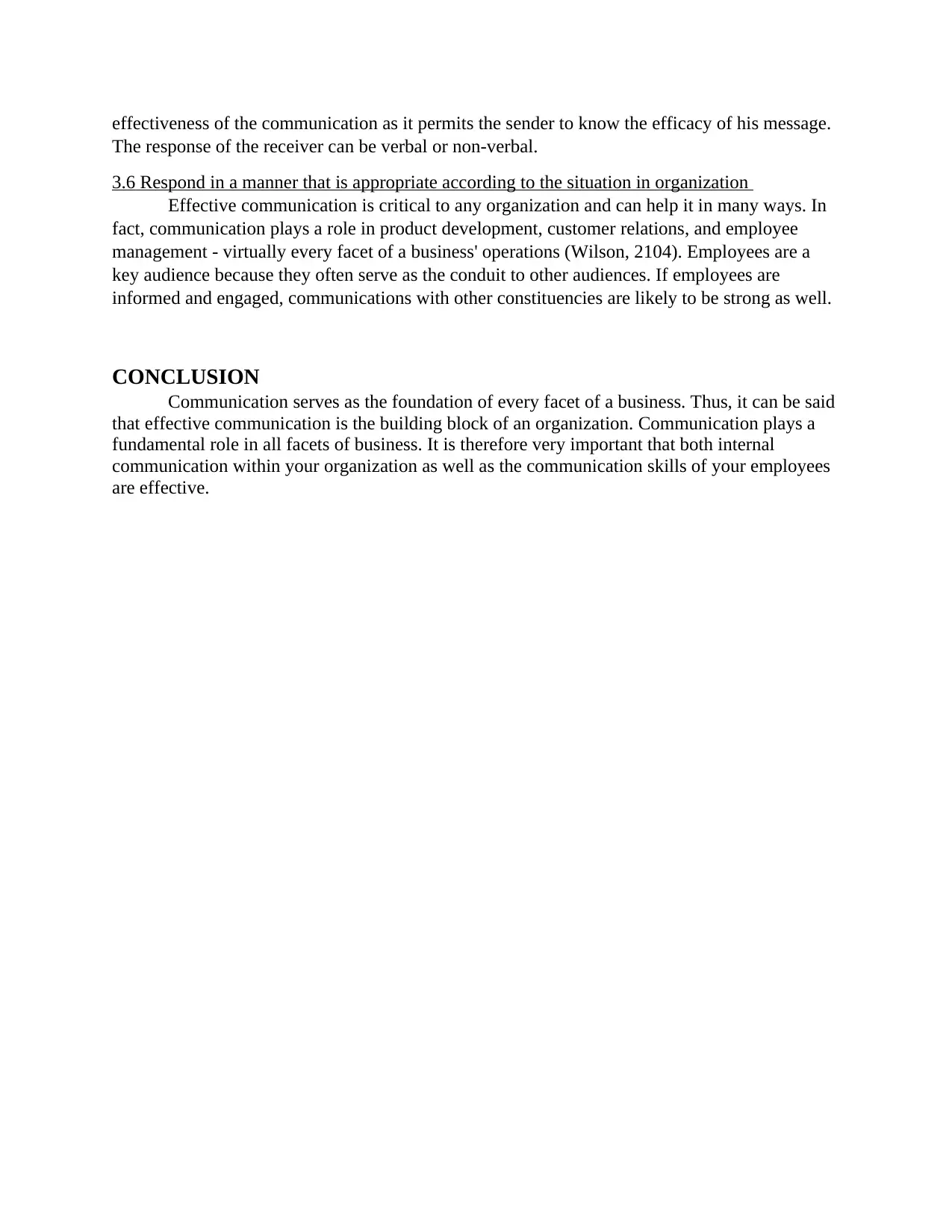
effectiveness of the communication as it permits the sender to know the efficacy of his message.
The response of the receiver can be verbal or non-verbal.
3.6 Respond in a manner that is appropriate according to the situation in organization
Effective communication is critical to any organization and can help it in many ways. In
fact, communication plays a role in product development, customer relations, and employee
management - virtually every facet of a business' operations (Wilson, 2104). Employees are a
key audience because they often serve as the conduit to other audiences. If employees are
informed and engaged, communications with other constituencies are likely to be strong as well.
CONCLUSION
Communication serves as the foundation of every facet of a business. Thus, it can be said
that effective communication is the building block of an organization. Communication plays a
fundamental role in all facets of business. It is therefore very important that both internal
communication within your organization as well as the communication skills of your employees
are effective.
The response of the receiver can be verbal or non-verbal.
3.6 Respond in a manner that is appropriate according to the situation in organization
Effective communication is critical to any organization and can help it in many ways. In
fact, communication plays a role in product development, customer relations, and employee
management - virtually every facet of a business' operations (Wilson, 2104). Employees are a
key audience because they often serve as the conduit to other audiences. If employees are
informed and engaged, communications with other constituencies are likely to be strong as well.
CONCLUSION
Communication serves as the foundation of every facet of a business. Thus, it can be said
that effective communication is the building block of an organization. Communication plays a
fundamental role in all facets of business. It is therefore very important that both internal
communication within your organization as well as the communication skills of your employees
are effective.
Paraphrase This Document
Need a fresh take? Get an instant paraphrase of this document with our AI Paraphraser
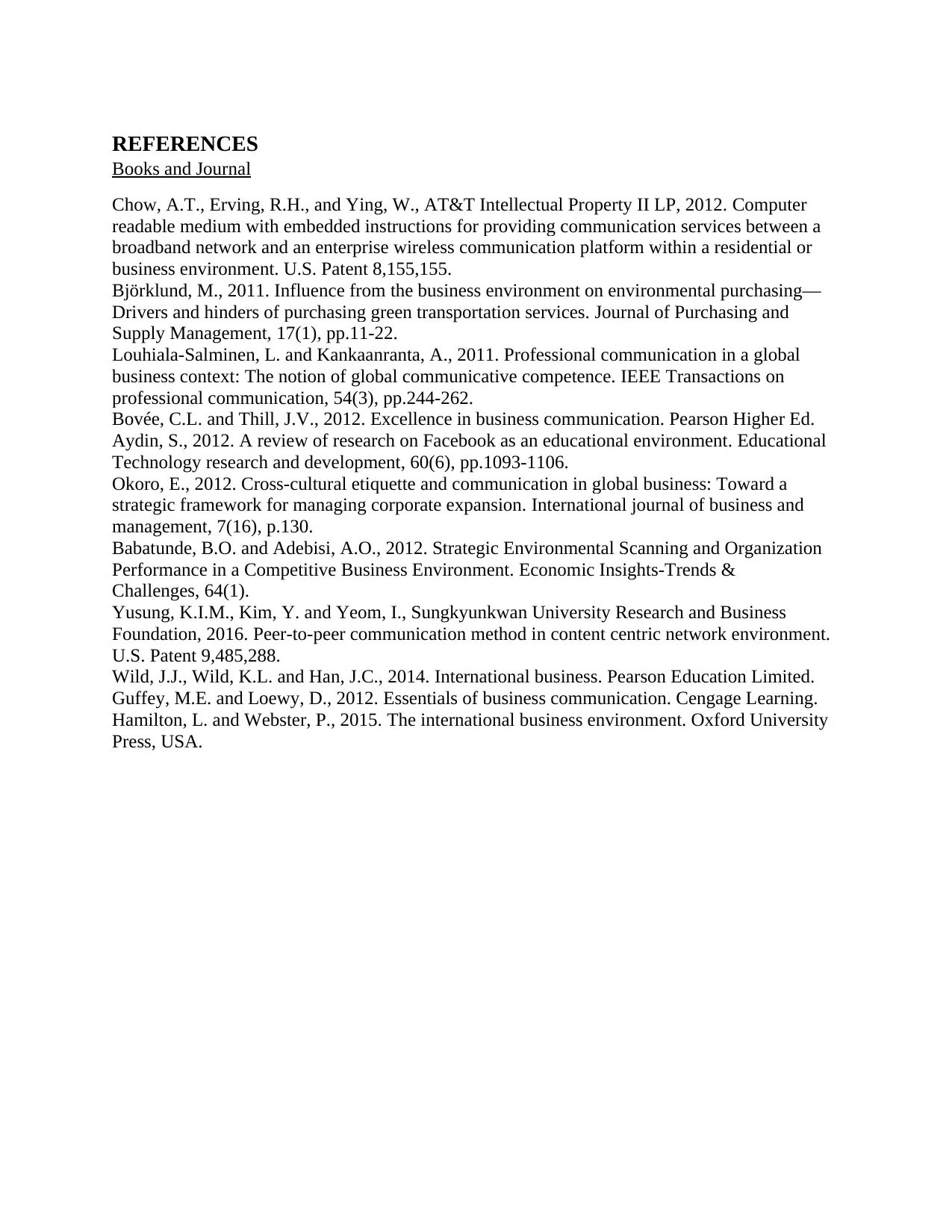
REFERENCES
Books and Journal
Chow, A.T., Erving, R.H., and Ying, W., AT&T Intellectual Property II LP, 2012. Computer
readable medium with embedded instructions for providing communication services between a
broadband network and an enterprise wireless communication platform within a residential or
business environment. U.S. Patent 8,155,155.
Björklund, M., 2011. Influence from the business environment on environmental purchasing—
Drivers and hinders of purchasing green transportation services. Journal of Purchasing and
Supply Management, 17(1), pp.11-22.
Louhiala-Salminen, L. and Kankaanranta, A., 2011. Professional communication in a global
business context: The notion of global communicative competence. IEEE Transactions on
professional communication, 54(3), pp.244-262.
Bovée, C.L. and Thill, J.V., 2012. Excellence in business communication. Pearson Higher Ed.
Aydin, S., 2012. A review of research on Facebook as an educational environment. Educational
Technology research and development, 60(6), pp.1093-1106.
Okoro, E., 2012. Cross-cultural etiquette and communication in global business: Toward a
strategic framework for managing corporate expansion. International journal of business and
management, 7(16), p.130.
Babatunde, B.O. and Adebisi, A.O., 2012. Strategic Environmental Scanning and Organization
Performance in a Competitive Business Environment. Economic Insights-Trends &
Challenges, 64(1).
Yusung, K.I.M., Kim, Y. and Yeom, I., Sungkyunkwan University Research and Business
Foundation, 2016. Peer-to-peer communication method in content centric network environment.
U.S. Patent 9,485,288.
Wild, J.J., Wild, K.L. and Han, J.C., 2014. International business. Pearson Education Limited.
Guffey, M.E. and Loewy, D., 2012. Essentials of business communication. Cengage Learning.
Hamilton, L. and Webster, P., 2015. The international business environment. Oxford University
Press, USA.
Books and Journal
Chow, A.T., Erving, R.H., and Ying, W., AT&T Intellectual Property II LP, 2012. Computer
readable medium with embedded instructions for providing communication services between a
broadband network and an enterprise wireless communication platform within a residential or
business environment. U.S. Patent 8,155,155.
Björklund, M., 2011. Influence from the business environment on environmental purchasing—
Drivers and hinders of purchasing green transportation services. Journal of Purchasing and
Supply Management, 17(1), pp.11-22.
Louhiala-Salminen, L. and Kankaanranta, A., 2011. Professional communication in a global
business context: The notion of global communicative competence. IEEE Transactions on
professional communication, 54(3), pp.244-262.
Bovée, C.L. and Thill, J.V., 2012. Excellence in business communication. Pearson Higher Ed.
Aydin, S., 2012. A review of research on Facebook as an educational environment. Educational
Technology research and development, 60(6), pp.1093-1106.
Okoro, E., 2012. Cross-cultural etiquette and communication in global business: Toward a
strategic framework for managing corporate expansion. International journal of business and
management, 7(16), p.130.
Babatunde, B.O. and Adebisi, A.O., 2012. Strategic Environmental Scanning and Organization
Performance in a Competitive Business Environment. Economic Insights-Trends &
Challenges, 64(1).
Yusung, K.I.M., Kim, Y. and Yeom, I., Sungkyunkwan University Research and Business
Foundation, 2016. Peer-to-peer communication method in content centric network environment.
U.S. Patent 9,485,288.
Wild, J.J., Wild, K.L. and Han, J.C., 2014. International business. Pearson Education Limited.
Guffey, M.E. and Loewy, D., 2012. Essentials of business communication. Cengage Learning.
Hamilton, L. and Webster, P., 2015. The international business environment. Oxford University
Press, USA.
1 out of 11
Related Documents
Your All-in-One AI-Powered Toolkit for Academic Success.
+13062052269
info@desklib.com
Available 24*7 on WhatsApp / Email
![[object Object]](/_next/static/media/star-bottom.7253800d.svg)
Unlock your academic potential
© 2024 | Zucol Services PVT LTD | All rights reserved.





